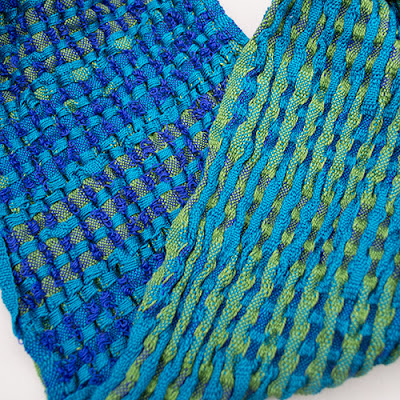Deflected doubleweave scarf woven by Katherine Luhring from my workshop,
"Weaving Outside the Box"
This month I'd like to share an essay by "Katzy" (pronounced "KAHtzee") Luhring, one of the managers at Lunatic Fringe Yarns. Some background: Over the summer, I taught "Weaving Outside the Box: 12 Projects for Creating Dimensional Cloth" at the Intermountain Weavers Conference in Logan, Utah, a workshop based on my book of the same name. We were lucky to have Katzy in our class, as she brought a lot of knowledge and information about some of the special yarns that are sold by Lunatic Fringe.
Here's a post she wrote for the Lunatic Fringe blog, starting with an introductory paragraph about her weaving adventures. Thank you, Katzy!
_____________________________________________________
We Lunatics have gone to a lot of conferences over the 30-plus years that we have been in business. However, it isn’t very often that we give ourselves the time to participate in the classes offered at the conferences. This year at IWC in Logan Utah, we sprang our fearless leader, Katzy, from booth duty so she could take Denise Kovnat’s dimensional-cloth workshop. Let her tell you about a few of the wonderful things she learned along the way.
By Katzy Luhring
Denise Kovnat’s dimensional-cloth workshop at IWC was a fabulous opportunity to experiment with interesting yarns and learn some new things! Denise asked all the class participants to choose a project from her book, "Weaving Outside the Box, 12 Projects for Creating Dimensional Cloth." I chose project #1, the Deflected-Doubleweave Scarf on four shafts. To be perfectly honest, I chose it because the project didn’t have too many ends, it used 10/2 mercerized cotton yarns, and it would fit on the 4-shaft Wolf Pup Loom that we had room to take with us to Logan. Seemed like a perfect fit all the way around!
I wanted to spend the workshop time making samples and learn more about elastic yarn during the workshop. To give myself plenty of warp for playing, I wound a six-yard warp of 10/2 Tubular Spectrum Thyme and 5 Blue. This was twice the warp length that Denise recommends in her book. I knew I would have plenty of warp to experiment to my heart's desire.
What Is Colcolastic Cotton Yarn?
Denise's instructions call for Colcolastic cotton yarn for one of the weft yarns. This is a yarn that I was unfamiliar with, but after a quick Internet search, I found it at Lone Star Loom Room. When I received the yarn (in a very short amount of time), I discovered that the yarn is a two-stranded yarn: One strand is 20/2 cotton and one strand is a thin elastic, and these two yarns are wound together onto the spool. I could make my own yarn by using one strand of 20/2 Tubular Spectrum mercerized cotton yarn and combining it with any of our thin elastic yarns: ramie, cotton, silk. The color possibilities are endless!
And how did these two yarns wind onto a bobbin? No problem there. I have since used both a hand winder and an electric bobbin winder to wind the spools from two cones and have not had any trouble with the yarns getting tangled either as I wound onto the spools or while I was weaving.
Play Time!
Three days of class trying different yarns and learning how the weave structure works and interacts with the weft yarns. It was heavenly! I tried elastic ramie, elastic silk, elastic cotton, both by themselves and with cotton yarns. I experimented with weft yarn colors to see how the two layers interacted. So much experimenting and so many things to try!
Not So Plain Weave.
Denise designed an interesting project: The first 18" is doubleweave with a top layer and a bottom layer. When I first warped the loom and sleyed the reed, I couldn't understand how we were going to get a functional fabric in those first 18" from the big spaces that are in between the yarns on each layer. There are gaps of about 1/4 inch! I trusted Denise's instructions and wove the fabric with the weft yarn floating across those gaps. When the fabric is washed, the warp yarn shifts over to fill the gaps and you can an interesting, almost plain-weave fabric with lots of drape.
Plain-weave section before washing
Plain-weave section after washing
Splash! Now to Make Things Go Bump!
The center section of the scarf contains the elastic and cotton weft. There is a nice texture to the fabric while on the loom, but it is relatively flat. And the fabric remains flat when you take it off the loom. The magic really happens when the fabric gets wet! When washed, the elastic in the weft shrinks up and takes the warp yarns along for a ride, creating ridges in the fabrics. The 20/2 weft yarns bubble up and make a loopy texture on one side of the fabric. You can stretch the fabric out to see how it originally looked, but when you let it go, the pleats reappear. Magical!
Center section before washing
Center section after washing
To the Loom!
When I left Logan, my brain was bursting with new ideas and I have been spending lots of time at the loom finishing up the first batch of scarves and working on new ones. Thanks Denise for a wonderful workshop!
Finished scarf before washing













No comments:
Post a Comment